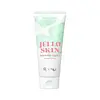What's inside
What's inside
 Key Ingredients
Key Ingredients

No key ingredients
 Benefits
Benefits

 Concerns
Concerns

 Ingredients Side-by-side
Ingredients Side-by-side

Paraffinum Liquidum
EmollientWater
Skin ConditioningButylene Glycol
HumectantCaprylic/Capric Triglyceride
MaskingTriethylhexanoin
MaskingGlycerin
HumectantCetyl Ethylhexanoate
EmollientPolysorbate 60
EmulsifyingGlyceryl Stearate Se
EmulsifyingOryza Sativa Extract
AbsorbentSaponaria Officinalis Leaf Extract
AntimicrobialPEG-100 Stearate
Glyceryl Stearate
EmollientSorbitan Sesquioleate
EmulsifyingCetearyl Alcohol
EmollientDimethicone
EmollientStearic Acid
CleansingTromethamine
BufferingCarbomer
Emulsion StabilisingAdenosine
Skin ConditioningTrisodium EDTA
Caramel
Cosmetic ColorantMethylparaben
PreservativePropylparaben
PreservativeEthylparaben
PreservativePhenoxyethanol
PreservativeCitrus Paradisi Fruit Extract
Skin ConditioningParfum
MaskingParaffinum Liquidum, Water, Butylene Glycol, Caprylic/Capric Triglyceride, Triethylhexanoin, Glycerin, Cetyl Ethylhexanoate, Polysorbate 60, Glyceryl Stearate Se, Oryza Sativa Extract, Saponaria Officinalis Leaf Extract, PEG-100 Stearate, Glyceryl Stearate, Sorbitan Sesquioleate, Cetearyl Alcohol, Dimethicone, Stearic Acid, Tromethamine, Carbomer, Adenosine, Trisodium EDTA, Caramel, Methylparaben, Propylparaben, Ethylparaben, Phenoxyethanol, Citrus Paradisi Fruit Extract, Parfum
Water
Skin ConditioningGlycerin
HumectantPropanediol
SolventHydrogenated Poly(C6-14 Olefin)
EmollientNiacinamide
SmoothingPolyglyceryl-6 Distearate
EmulsifyingCetearyl Alcohol
EmollientPropylheptyl Caprylate
EmollientAmmonium Acryloyldimethyltaurate/Vp Copolymer
Candelilla/Jojoba/Rice Bran Polyglyceryl-3 Esters
Emulsifying1,2-Hexanediol
Skin ConditioningVinyldimethicone
Glyceryl Stearate
EmollientMethyl Trimethicone
Skin ConditioningHydroxyacetophenone
AntioxidantDipropylene Glycol
HumectantLaminaria Japonica Extract
Skin ProtectingEclipta Prostrata Leaf Extract
Skin ConditioningCoptis Japonica Root Extract
Skin ConditioningButylene Glycol
HumectantOryza Sativa Bran Oil
EmollientEthylhexylglycerin
Skin ConditioningXanthan Gum
EmulsifyingSodium Stearoyl Glutamate
CleansingFructooligosaccharides
HumectantAdenosine
Skin ConditioningGlyceryl Polymethacrylate
Hydrogenated Lecithin
EmulsifyingBeta-Glucan
Skin ConditioningPanthenol
Skin ConditioningHydrolyzed Hyaluronic Acid
HumectantMaltodextrin
AbsorbentTocopherol
AntioxidantMethylpropanediol
SolventHydrolyzed Gardenia Florida Extract
AntioxidantCeramide NP
Skin ConditioningOpuntia Coccinellifera Fruit Extract
Skin ConditioningPhaseolus Vulgaris Seed Extract
Skin ConditioningWater, Glycerin, Propanediol, Hydrogenated Poly(C6-14 Olefin), Niacinamide, Polyglyceryl-6 Distearate, Cetearyl Alcohol, Propylheptyl Caprylate, Ammonium Acryloyldimethyltaurate/Vp Copolymer, Candelilla/Jojoba/Rice Bran Polyglyceryl-3 Esters, 1,2-Hexanediol, Vinyldimethicone, Glyceryl Stearate, Methyl Trimethicone, Hydroxyacetophenone, Dipropylene Glycol, Laminaria Japonica Extract, Eclipta Prostrata Leaf Extract, Coptis Japonica Root Extract, Butylene Glycol, Oryza Sativa Bran Oil, Ethylhexylglycerin, Xanthan Gum, Sodium Stearoyl Glutamate, Fructooligosaccharides, Adenosine, Glyceryl Polymethacrylate, Hydrogenated Lecithin, Beta-Glucan, Panthenol, Hydrolyzed Hyaluronic Acid, Maltodextrin, Tocopherol, Methylpropanediol, Hydrolyzed Gardenia Florida Extract, Ceramide NP, Opuntia Coccinellifera Fruit Extract, Phaseolus Vulgaris Seed Extract
 Reviews
Reviews

Ingredients Explained
These ingredients are found in both products.
Ingredients higher up in an ingredient list are typically present in a larger amount.
Adenosine is in every living organism. It is one of four components in nucleic acids that helps store our DNA.
Adenosine has many benefits when used. These benefits include hydrating the skin, smoothing skin, and reducing wrinkles. Once applied, adenosine increases collagen production. It also helps with improving firmness and tissue repair.
Studies have found adenosine may also help with wound healing.
In skincare products, Adenosine is usually derived from yeast.
Learn more about AdenosineButylene Glycol (or BG) is used within cosmetic products for a few different reasons:
Overall, Butylene Glycol is a safe and well-rounded ingredient that works well with other ingredients.
Though this ingredient works well with most skin types, some people with sensitive skin may experience a reaction such as allergic rashes, closed comedones, or itchiness.
Learn more about Butylene GlycolCetearyl alcohol is a mixture of two fatty alcohols: cetyl alcohol and stearyl alcohol. It is mainly used as an emulsifier. Emulsifiers help prevent the separation of oils and products. Due to its composition, it can also be used to thicken a product or help create foam.
Cetearyl alcohol is an emollient. Emollients help soothe and hydrate the skin by trapping moisture.
Studies show Cetearyl alcohol is non-toxic and non-irritating. The FDA allows products labeled "alcohol-free" to have fatty alcohols.
This ingredient is usually derived from plant oils such as palm, vegetable, or coconut oils. There is debate on whether this ingredient will cause acne.
Due to the fatty acid base, this ingredient may not be Malassezia folliculitis safe.
Learn more about Cetearyl AlcoholGlycerin is already naturally found in your skin. It helps moisturize and protect your skin.
A study from 2016 found glycerin to be more effective as a humectant than AHAs and hyaluronic acid.
As a humectant, it helps the skin stay hydrated by pulling moisture to your skin. The low molecular weight of glycerin allows it to pull moisture into the deeper layers of your skin.
Hydrated skin improves your skin barrier; Your skin barrier helps protect against irritants and bacteria.
Glycerin has also been found to have antimicrobial and antiviral properties. Due to these properties, glycerin is often used in wound and burn treatments.
In cosmetics, glycerin is usually derived from plants such as soybean or palm. However, it can also be sourced from animals, such as tallow or animal fat.
This ingredient is organic, colorless, odorless, and non-toxic.
Glycerin is the name for this ingredient in American English. British English uses Glycerol/Glycerine.
Learn more about GlycerinGlyceryl Stearate is a mix of glycerin and stearic acid.
It is used to stabilize the mixing of water and oil ingredients. By preventing these ingredients from separating, it can help elongate shelf life. It can also help thicken the product's texture.
As an emollient, it helps soften skin and supports barrier-replenishing ingredients.
In cosmetics, Glyceryl Stearate is often made from vegetable oils or synthetically produced.
This ingredient may not be fungal-acne safe
Fun fact: The human body also creates Glyceryl Stearate naturally.
Learn more about Glyceryl StearateWater. It's the most common cosmetic ingredient of all. You'll usually see it at the top of ingredient lists, meaning that it makes up the largest part of the product.
So why is it so popular? Water most often acts as a solvent - this means that it helps dissolve other ingredients into the formulation.
You'll also recognize water as that liquid we all need to stay alive. If you see this, drink a glass of water. Stay hydrated!
Learn more about Water